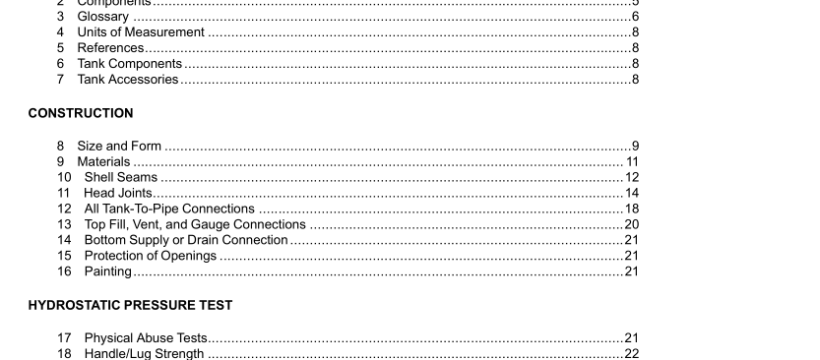UL 80-2019 pdf download.Steel Tanks for Oil-Burner Fuels and Other Combustible Liquids.
3.26 USED OILS – General description of oils such as those drained from motor vehicles or cooking appliances after use that do not contain water, gas or other contaminants that change the oil Class or may adversely affect the storage tank. 3.27 VENT OPENING – A storage tank top opening that is intended to provide both normal venting (equalizing pressure from fill, withdraw or atmospheric changes typically up to 1.0 psig) and emergency venting (relief of excessive pressure from external fire exposure typically not to exceed 2.5 psig). 3.28 WASTE OIL – General description of oils such as those drained from motor vehicles or cooking appliances after use that contain some amounts of water, gasoline, diesel, or other contaminants that change the oil Class or may adversely affect the storage tank. 4 Units of Measurement 4.1 Values stated without parentheses are the requirement. Values in parentheses are explanatory or approximate information. 5 References 5.1 Any undated reference to a code or standard appearing in the requirements of this standard shall be interpreted as referring to the latest edition of that code or standard.
6 Tank Components 6.1 The following tank components shall be permitted to be provided as either an attached part of a complete tank, or packed with a tank for assembly per the manufacturers instructions at the installation site. When provided, these components shall comply with all applicable requirements of the Standards identified below: a) Fuel Filters or Oil Deairators in accordance with the Standard for Strainers for Flammable Fluids and Anhydrous Ammonia, UL 331, rated at least 25 psig, for use with combustible liquids described in the Scope, and intended for connection to the burner supply. b) Fusible Link Valves or Shutoff Valves in accordance with the Standard for Valves for Flammable Fluids, UL 842, rated at least 25 psig, for use with the combustible liquids described in the Scope, and intended for connection to the burner supply. c) Liquid Level Gauges in accordance with the Standard for Liquid-Level Indicating Gauges for Oil Burner Fuels, UL 180, rated at least 25 psig, for use with the combustible liquids described in the Scope, and intended for use in top openings. 7 Tank Accessories 7.1 The following tank accessories shall be permitted to be provided as either an attached part of a complete tank, or packed with a tank for assembly per the manufacturers instructions at the installation site. When provided, these accessories shall comply with all applicable requirements identified below: a) Spill Containers shall be steel leak tight constructions integral to the tank with attached covers, and shall have a minimum 1 gallon (3.8 L) capacity for use around top openings such as fill and vents. b) Piping for leg supports shall be minimum schedule 40 ASME B36.10M black pipe in sizes and threads to fit the integral leg brackets and shall comply with the requirements in Sections 17 – 22.
8 Size and Form 8.1 A tank of this class shall be cylindrical, obround, rectangular, or of another form which complies with all applicable performance tests, but shall not exceed a primary tank capacity of 660 gallons (2500 L). The marked nominal capacity shall be within 95 – 100 percent of the actual capacity. 8.2 A primary or secondary cylindrical tank shall have a maximum diameter of 48 inches (1.21 m) and shall be permitted to have flat, stamped, or dished heads. 8.3 A primary or secondary obround tank shall be formed in accordance with Figure 12.2, and shall be permitted to have flat, stamped, or dished heads between 38 to 48 inches in the greater dimension, and 18 to 28 inches in the lesser dimension. 8.4 A primary or secondary rectangular tank shall be formed with all sides flat at right angles, except for tops to allow drainage, with any one side not less than 12 inches or more than 90 inches. 8.5 Secondary tanks shall have containment to at least 300 degrees or 95 percent height of the primary tank and an interstitial space capable of being vented and monitored. The secondary tank walls are permitted to be in direct contact or separated by supporting members. 8.6 The secondary shall not have any drains or shell penetrations except for welded through connections for burner supply piping or top fittings from the primary tank, or the secondary interstitial vent. 8.7 The secondary shall be of a construction that provides liquid communication to the monitor area. 8.8 The secondary top opening shall be permitted to combine venting and monitoring.UL 80-2019 pdf download.
UL 80-2019 pdf download
